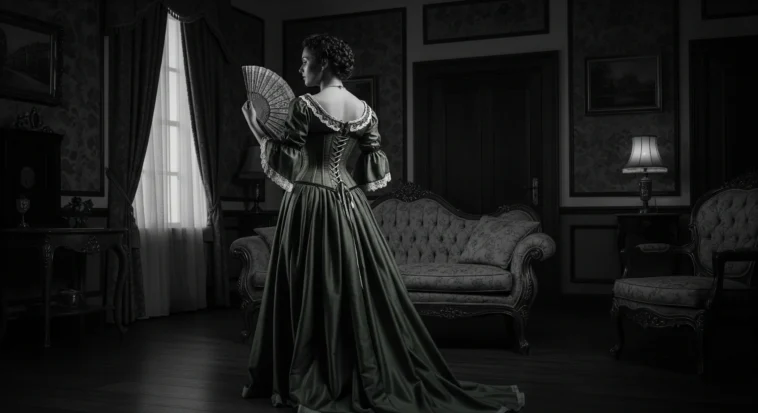
Victorian women fainting wasn’t just drama for the camera—it really happened, a lot.
But it wasn’t all about being “too emotional.”
Historians and doctors say a mix of tight corsets, bad air, and strict social rules made fainting a real health issue.
The Reality Behind the Romance: Victorian Fainting Was Real
Victorian women really did faint a lot—way more than women today.
Modern doctors and historians back this up.
Even now, studies show women faint more often than men (around 40–45% vs. 25%), and in the 1800s, the gap was even bigger.
Fainting became such a normal part of daily life that rich households had special furniture just for it.
Yep—fainting couches were a real thing. These weren’t just for style.
They were made so women could lie down quickly when they felt dizzy.
Some homes even had entire “fainting rooms.”
Imagine needing a whole room because passing out was that common. It wasn’t just drama—it was reality.
- Read also: Legendary Women: 5 Famous Women of the Middle Ages
- Read also: Pioneers and Visionaries: 8 Great Women of Ancient Persia

The Corset Conundrum: Fashion’s Dangerous Grip
If you’ve ever held your breath to squeeze into tight jeans, imagine doing that all day, every day.
That was real life for Victorian women.
Corsets weren’t just fashion—they were serious business. And yeah, they made women pass out. A lot.
Why corsets made women faint?
Corsets were designed to shrink waists down to ridiculous sizes—sometimes just 17 inches.
That’s smaller than a laptop screen. To pull this off, women used hardcore lacing techniques.
Their maids would even shove a knee into their back to yank the laces tight.
All this to get the “perfect” hourglass shape, because society said small waists were beautiful.
But tight-lacing wasn’t just uncomfortable—it messed up the body big time.
Doctors at the time started noticing the damage and called it out.
What actually went wrong in the body?
Breathing got crushed
Corsets squeezed the ribs and lungs so hard that it was hard to breathe.
Less oxygen in = less oxygen to the brain = boom, you faint.
Your brain basically said, “Nope, shutting down.”
Organs got pushed around
The pressure didn’t stop at the lungs.
Corsets shoved everything—stomach, liver, uterus—into places they weren’t meant to be.
Eating was tough, digestion got weird, and some women developed internal problems that lasted for years.
Circulation took a hit
Tight lacing also messed with blood flow.
With poor circulation, your brain doesn’t get enough oxygen or nutrients.
And surprise: when your brain doesn’t get what it needs, you’re way more likely to black out.
The Hidden Killer in the Wallpaper: Environmental Toxicity
Victorian women didn’t just faint because of corsets—they were also literally surrounded by poison. And they didn’t even know it.
Arsenic was in the wallpaper
That fancy green wallpaper everyone loved? Yeah, it was full of arsenic.
This stuff is toxic—like, “used in rat poison” toxic.
Doctors back then didn’t fully get it, but now we know arsenic poisoning causes headaches, sweating, nausea… and yep, fainting.
One woman reportedly passed out almost every day—until someone moved her to a room without arsenic-covered walls.
She got better. No surprise there.
Makeup was basically a chemistry lab of doom
It didn’t stop at the wallpaper. Arsenic, lead, and mercury were in makeup, hair dye, and skin creams. All in the name of beauty.
Want pale skin? There’s arsenic for that.
Want shiny hair? Here’s some lead. These products slowly poisoned people.
Fainting was just one of the early warning signs.

Nutritional Deficiencies: The Price of Propriety
In Victorian times, food wasn’t just fuel—it was tied to morals and image.
Especially for upper-class women, eating too much was seen as greedy or unladylike.
So many of them simply… didn’t eat enough.
Fainting from hunger was totally a thing
Tight corsets made eating a full meal nearly impossible.
Add to that the pressure to be thin and “proper,” and you get a recipe for nonstop low blood sugar.
Missing meals = low energy = brain says “nope” and you faint.
This wasn’t about drama—it was biology.
Iron deficiency made it worse
Their diets lacked iron, especially if they were pregnant.
This caused anemia, which makes you weak and dizzy.
And guess what corsets didn’t help with? Eating iron-rich food.
So you’ve got tight laces, skipped meals, social pressure, and barely any nutrients.
That’s not just a bad lunch break—it’s a full-blown health spiral.
The Multifaceted Truth
Let’s clear something up: Victorian fainting wasn’t just about tight clothes or being “dramatic.”
It was a mix of health issues, bad science, and messed-up social rules.
Here’s what really went down:
Corsets were crushing everything
Corsets looked fancy, but they made it hard to breathe, eat, or even sit comfortably.
They squished lungs, pushed around organs, and made meals tiny or impossible.
No oxygen + no food = your brain taps out. Faint.
Poison was hiding in plain sight
That gorgeous green wallpaper? Full of arsenic.
Same with some makeup, skin creams, and hair dye—loaded with toxic stuff like lead and mercury.
These poisons messed with the body long-term. Headaches, weakness, dizzy spells, and yep—more fainting.
Eating was basically a social crime
Women were expected to eat like birds. Being hungry was seen as ladylike.
Plus, corsets made big meals uncomfortable. Many women ran on almost nothing—no iron, no calories, no energy.
Cue low blood sugar and anemia. More fainting.
Lessons from the Past
Victorian women fainted for a bunch of reasons—tight corsets, toxic makeup, messed-up diets, and a society that told them to be quiet and delicate.
And while we’re not dealing with arsenic wallpaper anymore (thankfully), the core lesson still hits: when beauty or social trends mess with your health, something’s gotta give.
Looks aren’t worth your health
Chasing extreme beauty standards always has a cost.
Back then, it was fainting, organ damage, and slow poisoning.
Today? It might look like crash diets, burnout, or body image issues. Same problem, just new packaging.
Science matters a lot
If Victorian doctors had known more about nutrition or toxic chemicals, they could’ve saved a lot of women from real suffering.
That’s why evidence-based medicine matters. It’s not just science class—it’s what keeps us from repeating bad history.

- Read also: From Artists to Rulers: 8 Famous Renaissance Women
- Read also: Breaking Barriers: 9 Women Philosophers in the Enlightenment Era
Conclusion
Victorian women fainted a lot—and not just for drama.
Tight corsets, toxic makeup, barely any food, and pressure to act “ladylike” created the perfect storm.
We’ve romanticized it, but fainting was a real health issue caused by fashion and social rules taken way too far.
The big lesson? Don’t let trends mess with your health.
And shoutout to those women—surviving all that makes them way tougher than we give them credit for.



